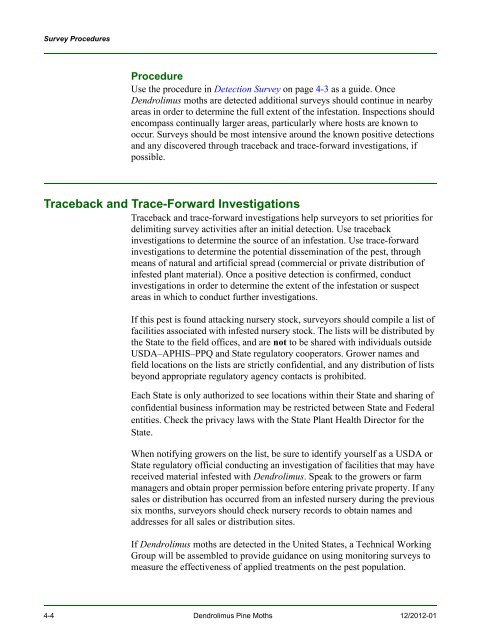New Pest Response Guidelines - aphis - US Department of Agriculture
New Pest Response Guidelines - aphis - US Department of Agriculture
New Pest Response Guidelines - aphis - US Department of Agriculture
You also want an ePaper? Increase the reach of your titles
YUMPU automatically turns print PDFs into web optimized ePapers that Google loves.
Survey Procedures<br />
Procedure<br />
Use the procedure in Detection Survey on page 4-3 as a guide. Once<br />
Dendrolimus moths are detected additional surveys should continue in nearby<br />
areas in order to determine the full extent <strong>of</strong> the infestation. Inspections should<br />
encompass continually larger areas, particularly where hosts are known to<br />
occur. Surveys should be most intensive around the known positive detections<br />
and any discovered through traceback and trace-forward investigations, if<br />
possible.<br />
Traceback and Trace-Forward Investigations<br />
Traceback and trace-forward investigations help surveyors to set priorities for<br />
delimiting survey activities after an initial detection. Use traceback<br />
investigations to determine the source <strong>of</strong> an infestation. Use trace-forward<br />
investigations to determine the potential dissemination <strong>of</strong> the pest, through<br />
means <strong>of</strong> natural and artificial spread (commercial or private distribution <strong>of</strong><br />
infested plant material). Once a positive detection is confirmed, conduct<br />
investigations in order to determine the extent <strong>of</strong> the infestation or suspect<br />
areas in which to conduct further investigations.<br />
If this pest is found attacking nursery stock, surveyors should compile a list <strong>of</strong><br />
facilities associated with infested nursery stock. The lists will be distributed by<br />
the State to the field <strong>of</strong>fices, and are not to be shared with individuals outside<br />
<strong>US</strong>DA–APHIS–PPQ and State regulatory cooperators. Grower names and<br />
field locations on the lists are strictly confidential, and any distribution <strong>of</strong> lists<br />
beyond appropriate regulatory agency contacts is prohibited.<br />
Each State is only authorized to see locations within their State and sharing <strong>of</strong><br />
confidential business information may be restricted between State and Federal<br />
entities. Check the privacy laws with the State Plant Health Director for the<br />
State.<br />
When notifying growers on the list, be sure to identify yourself as a <strong>US</strong>DA or<br />
State regulatory <strong>of</strong>ficial conducting an investigation <strong>of</strong> facilities that may have<br />
received material infested with Dendrolimus. Speak to the growers or farm<br />
managers and obtain proper permission before entering private property. If any<br />
sales or distribution has occurred from an infested nursery during the previous<br />
six months, surveyors should check nursery records to obtain names and<br />
addresses for all sales or distribution sites.<br />
If Dendrolimus moths are detected in the United States, a Technical Working<br />
Group will be assembled to provide guidance on using monitoring surveys to<br />
measure the effectiveness <strong>of</strong> applied treatments on the pest population.<br />
4-4 Dendrolimus Pine Moths 12/2012-01

















